Ocean research in a time of COVID-19
by Kim Fulton-Bennett, Monterey Bay Aquarium Research Institute
 During the Summer 2020 CANON experiment, these two Wave Gliders have been zig-zagging over Monterey Canyon, using echosounders to locate fish and other animals in the water below. The echosounders are the cylindrical devices near the back of each Wave Glider. The olive-green foils under the Wave Gliders help propel these autonomous robots across the sea surface. Credit: Chris Wahl/MBARI
During the Summer 2020 CANON experiment, these two Wave Gliders have been zig-zagging over Monterey Canyon, using echosounders to locate fish and other animals in the water below. The echosounders are the cylindrical devices near the back of each Wave Glider. The olive-green foils under the Wave Gliders help propel these autonomous robots across the sea surface. Credit: Chris Wahl/MBARIThe COVID-19 pandemic has made it especially challenging for marine scientists to make observations and carry out experiments at sea. Research cruises have been cut back or canceled because it is difficult to keep a safe distance between scientists and crew in the tight spaces on a research vessel. In this current situation, MBARI's robotic vehicles and instruments have proven to be very useful.
A case in point is MBARI's Summer 2020 Controlled, Agile, and Novel Ocean Network (CANON) experiment, which runs from July 14 to August 4. Research Associate Katie Pitz, who was involved in planning the operation, explained, "For this year's experiment, the actual sampling is being done by autonomous instruments and vehicles that can be monitored remotely by scientists onshore. MBARI has been advancing autonomous technologies for a long time, so this is a great example of how we can apply these technologies."
MBARI's annual CANON experiments typically employ large numbers of ships, robots, and instruments that are deployed more or less simultaneously on Monterey Bay to collect data related to a specific physical and biological process in the bay. CANON experiments are also opportunities for researchers to test out new, cutting-edge technologies.
This year's CANON experiment is designed to study large groups of anchovies and other animals in and around Monterey Canyon. To figure out where and when these animals congregate in the canyon, researchers from MBARI and the National Oceanic and Atmospheric Administration (NOAA) are combining two very different technologies—high-resolution echosounders and environmental DNA (eDNA).
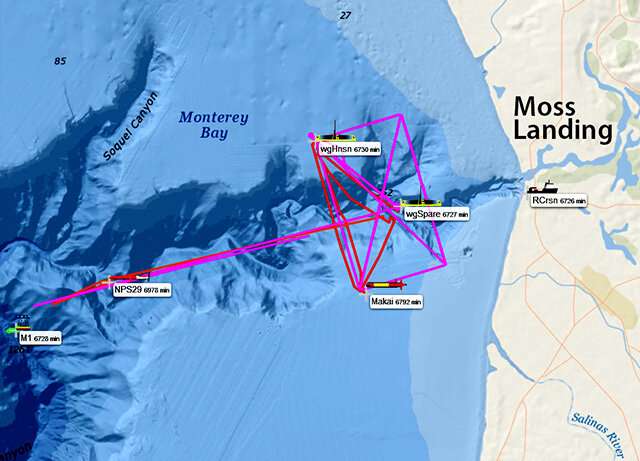
This map, created by MBARI’s Oceanographic Decision Support System, shows the paths that Wave Gliders and long-range AUVs took as they monitored animals in Monterey Canyon during the Summer 2020 CANON experiment. Credit: MBARI
Scientific echosounders use sound waves to create images of layers of animals at different depths and, in some cases, even allow scientists to identify these animals. With eDNA analysis, biologists can determine what kinds of organisms are in a patch of ocean simply by collecting a sample of seawater and extracting DNA from that seawater. DNA sequences from the seawater are then compared with known DNA sequences for a variety of different organisms.
"This technology is analogous to a forensic investigator who finds DNA at a crime scene and compares it to the bank of suspects in the FBI genetic repository," said Francisco Chavez, lead researcher on the CANON experiments. "Our suspects," he continued, "are life in the sea."
As Pitz noted, NOAA is very interested in exploring this new approach. "Microbiologist Kelly Goodwin at NOAA arranged the funding for MBARI to collect eDNA samples and compare the results with echosounder observations. Originally we were going to have a NOAA ship be part of the experiment, but because of the pandemic, the ship was not able to be here."
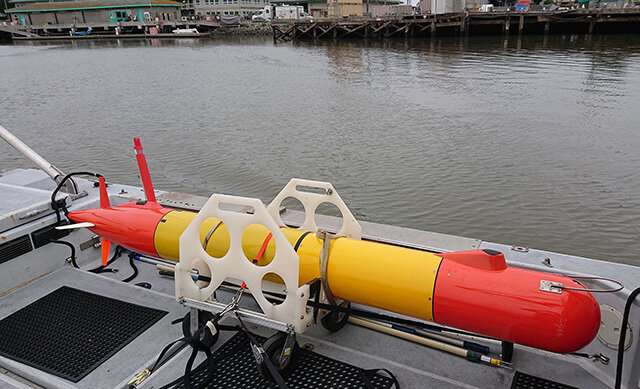
Scientific echosounders use sound waves to create images of layers of animals at different depths and, in some cases, even allow scientists to identify these animals. With eDNA analysis, biologists can determine what kinds of organisms are in a patch of ocean simply by collecting a sample of seawater and extracting DNA from that seawater. DNA sequences from the seawater are then compared with known DNA sequences for a variety of different organisms.
"This technology is analogous to a forensic investigator who finds DNA at a crime scene and compares it to the bank of suspects in the FBI genetic repository," said Francisco Chavez, lead researcher on the CANON experiments. "Our suspects," he continued, "are life in the sea."
As Pitz noted, NOAA is very interested in exploring this new approach. "Microbiologist Kelly Goodwin at NOAA arranged the funding for MBARI to collect eDNA samples and compare the results with echosounder observations. Originally we were going to have a NOAA ship be part of the experiment, but because of the pandemic, the ship was not able to be here."

Inside of this underwater robot (a long-range autonomous underwater vehicle or LRAUV) is a robotic laboratory called an Environmental Sample Processor, which collects samples of seawater then extracts environmental DNA for later analysis onshore. Credit: Erik Trauschke/MBARI
"This research applies directly to NOAA's studies of fish stocks," Pitz explained. "They use echosounders on ships to map the distribution of fish and nets to verify which fish are present. During CANON, we are doing the same thing, except we are using echosounders mounted on robots at the surface and collecting eDNA using underwater robots."
The surface robots used in the CANON experiment are called "Wave Gliders," and look like squared-off surfboards. Throughout the experiment, one Wave Glider is traveling a zig-zag path over the inner part of Monterey Canyon, where anchovy schools are often found. As the Wave Glider moves across the surface, its echosounders capture images of schools of anchovies and other animals in the water below.
Following the Wave Glider on its zig-zag course is an underwater robot called a long-range autonomous underwater vehicle (LRAUV), which is collecting water samples for eDNA analysis. Over the two-week experiment, the LRAUV will collect up to 60 water samples using an MBARI-designed robotic sampling device called an Environmental Sample Processor (ESP). "This is one of the first times we have used the LRAUV to collect samples underwater at the same locations the acoustic Wave Glider is visiting at the surface," said Pitz.
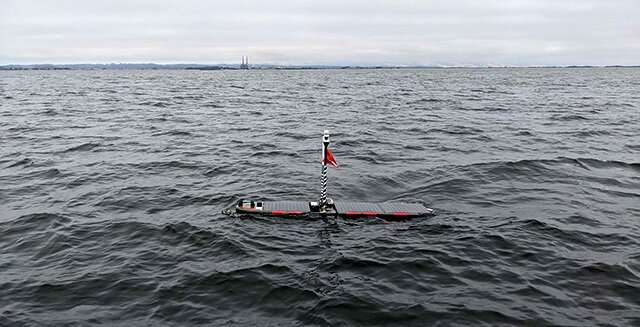
"This research applies directly to NOAA's studies of fish stocks," Pitz explained. "They use echosounders on ships to map the distribution of fish and nets to verify which fish are present. During CANON, we are doing the same thing, except we are using echosounders mounted on robots at the surface and collecting eDNA using underwater robots."
The surface robots used in the CANON experiment are called "Wave Gliders," and look like squared-off surfboards. Throughout the experiment, one Wave Glider is traveling a zig-zag path over the inner part of Monterey Canyon, where anchovy schools are often found. As the Wave Glider moves across the surface, its echosounders capture images of schools of anchovies and other animals in the water below.
Following the Wave Glider on its zig-zag course is an underwater robot called a long-range autonomous underwater vehicle (LRAUV), which is collecting water samples for eDNA analysis. Over the two-week experiment, the LRAUV will collect up to 60 water samples using an MBARI-designed robotic sampling device called an Environmental Sample Processor (ESP). "This is one of the first times we have used the LRAUV to collect samples underwater at the same locations the acoustic Wave Glider is visiting at the surface," said Pitz.

A Wave Glider glides across Monterey Bay during the Summer 2020 CANON experiment. Image: Chris Wahl/MBARI
Though robots are doing most of the sample and data collection, over two dozen humans are also involved in this experiment. All of these scientists, engineers, and marine operations staff are needed to launch, recover, and maintain the robots, and to process and analyze the samples and data.
At the end of the experiment, after all the robots return to shore, CANON scientists and engineers will begin processing hundreds of samples for eDNA analysis. "During my first CANON experiment in Spring 2017, we collected only four eDNA samples autonomously," said Pitz. "Now, with multiple ESPs, we have a huge increase in the number of samples we can collect and will need to process."
"It's a lot of work," she added. "But having more samples is great for the science. And the samples can be stored in a freezer and preserved for years. Analytical methods for eDNA are improving rapidly, so it's nice to preserve some samples for later analysis in case a better technique comes along."
Though robots are doing most of the sample and data collection, over two dozen humans are also involved in this experiment. All of these scientists, engineers, and marine operations staff are needed to launch, recover, and maintain the robots, and to process and analyze the samples and data.
At the end of the experiment, after all the robots return to shore, CANON scientists and engineers will begin processing hundreds of samples for eDNA analysis. "During my first CANON experiment in Spring 2017, we collected only four eDNA samples autonomously," said Pitz. "Now, with multiple ESPs, we have a huge increase in the number of samples we can collect and will need to process."
"It's a lot of work," she added. "But having more samples is great for the science. And the samples can be stored in a freezer and preserved for years. Analytical methods for eDNA are improving rapidly, so it's nice to preserve some samples for later analysis in case a better technique comes along."
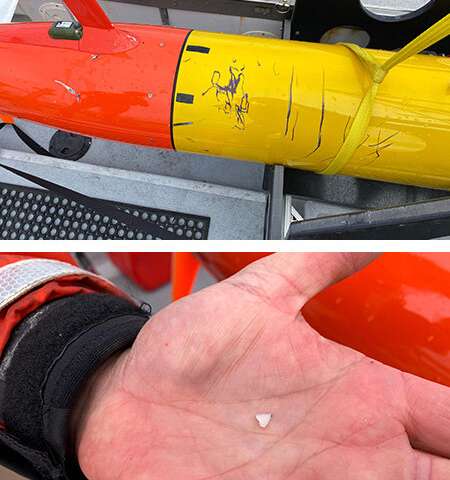
Studying the ocean can be risky for robots as well as for humans. During the Summer 2020 CANON experiment, one LRAUV was bitten by a shark. Researchers pulled several fragments of shark teeth from the hull of the vehicle. Credit: Top image: Brian Kieft/MBARI; Bottom image: Ben Yair Raanan/MBARI
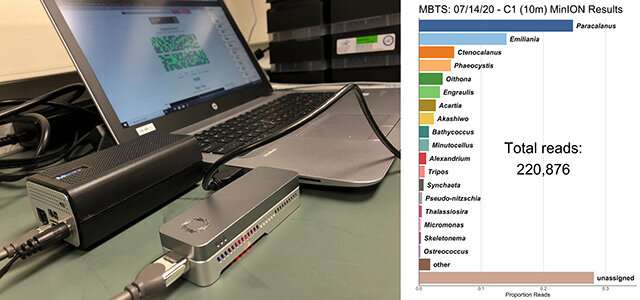 During the Summer 2020 CANON experiment, researchers are testing small “benchtop” DNA sequencers that plug directly into a laptop computer. After analyzing one water sample, the sequencer produced a graph showing how much DNA was detected from different types of animals, including anchovies, copepods, and microscopic algae. Credit: Charles Nye/MBAR
During the Summer 2020 CANON experiment, researchers are testing small “benchtop” DNA sequencers that plug directly into a laptop computer. After analyzing one water sample, the sequencer produced a graph showing how much DNA was detected from different types of animals, including anchovies, copepods, and microscopic algae. Credit: Charles Nye/MBAR
"Speaking of cutting edge technologies," Pitz said, "Another cool aspect of this experiment is that MBARI scientists Nathan Truelove and Charles Nye are using a desktop sequencer to sequence eDNA from water samples in near real-time—within a day or so."
"Benchtop sequencing has a higher error rate in reading the DNA than next-generation methods that involve large sequencing machines," she explained. "So the data processing is a lot more challenging. But being able to sequence DNA in a day would be great compared to shipping samples out to a lab, which can take several weeks. Eventually, we hope to be able to host this tiny sequencer on our LRAUV."
Although MBARI engineers have had great success building robots that communicate effectively with one another, Pitz noted that one of the biggest challenges in this experiment is keeping lines of communication open among the humans involved. "We need to decide the best times and places to collect samples while making sure the LRAUV doesn't burn out its battery or hit the bottom. This requires lots of communicating between the scientists, engineers, and marine operations staff. As a scientist at MBARI, one of the things I've learned is that, in order to get good scientific data, you need to work closely with the engineers to understand and adapt to the limitations of the equipment."
The Summer 2020 CANON experiment is a prime example of how researchers can collect vast amounts of useful data by sending robots instead of people out to sea. "This mode of operation will increase dramatically in the future," said Chavez. "Not only because of COVID but because of the need for persistent and globally distributed observations of life in the sea."
Explore furtherAn autonomous vehicle coupled with a robotic laboratory proves its worth
 During the Summer 2020 CANON experiment, researchers are testing small “benchtop” DNA sequencers that plug directly into a laptop computer. After analyzing one water sample, the sequencer produced a graph showing how much DNA was detected from different types of animals, including anchovies, copepods, and microscopic algae. Credit: Charles Nye/MBAR
During the Summer 2020 CANON experiment, researchers are testing small “benchtop” DNA sequencers that plug directly into a laptop computer. After analyzing one water sample, the sequencer produced a graph showing how much DNA was detected from different types of animals, including anchovies, copepods, and microscopic algae. Credit: Charles Nye/MBAR"Speaking of cutting edge technologies," Pitz said, "Another cool aspect of this experiment is that MBARI scientists Nathan Truelove and Charles Nye are using a desktop sequencer to sequence eDNA from water samples in near real-time—within a day or so."
"Benchtop sequencing has a higher error rate in reading the DNA than next-generation methods that involve large sequencing machines," she explained. "So the data processing is a lot more challenging. But being able to sequence DNA in a day would be great compared to shipping samples out to a lab, which can take several weeks. Eventually, we hope to be able to host this tiny sequencer on our LRAUV."
Although MBARI engineers have had great success building robots that communicate effectively with one another, Pitz noted that one of the biggest challenges in this experiment is keeping lines of communication open among the humans involved. "We need to decide the best times and places to collect samples while making sure the LRAUV doesn't burn out its battery or hit the bottom. This requires lots of communicating between the scientists, engineers, and marine operations staff. As a scientist at MBARI, one of the things I've learned is that, in order to get good scientific data, you need to work closely with the engineers to understand and adapt to the limitations of the equipment."
The Summer 2020 CANON experiment is a prime example of how researchers can collect vast amounts of useful data by sending robots instead of people out to sea. "This mode of operation will increase dramatically in the future," said Chavez. "Not only because of COVID but because of the need for persistent and globally distributed observations of life in the sea."
Explore furtherAn autonomous vehicle coupled with a robotic laboratory proves its worth
Provided by Monterey Bay Aquarium Research Institute
No comments:
Post a Comment